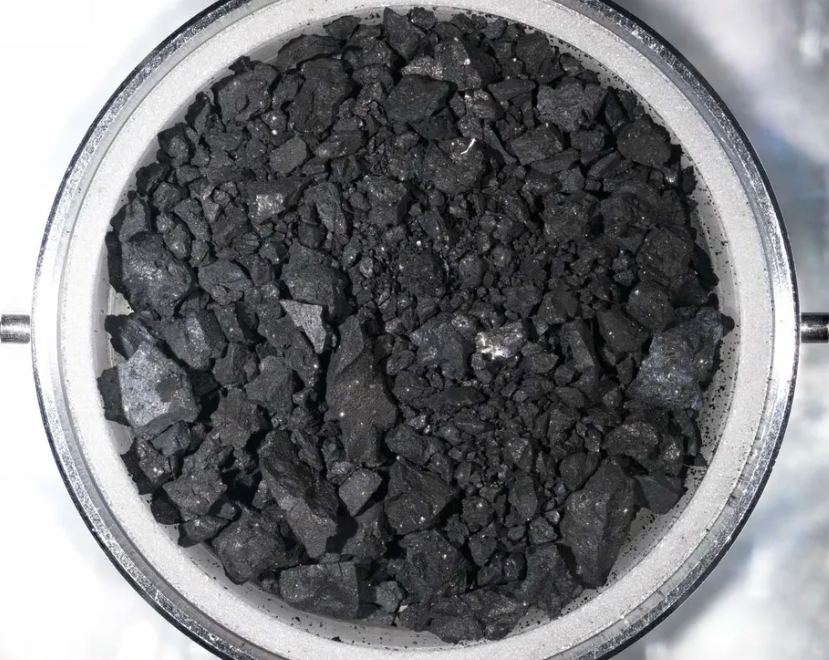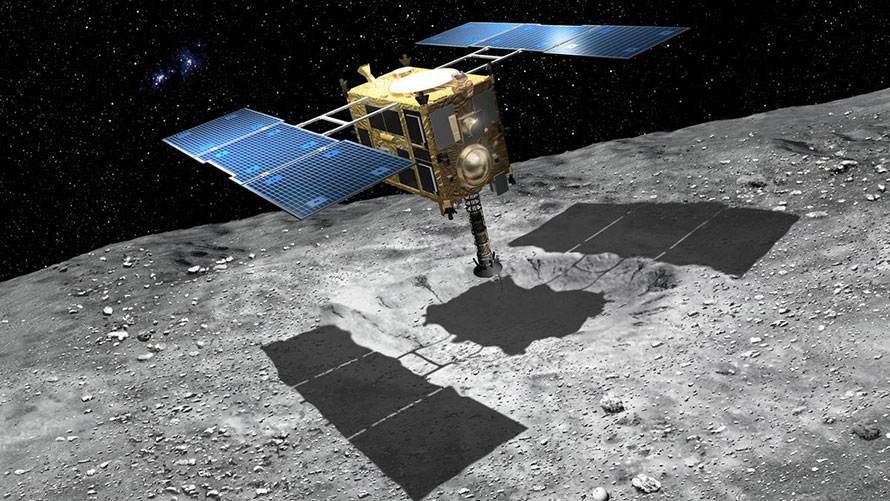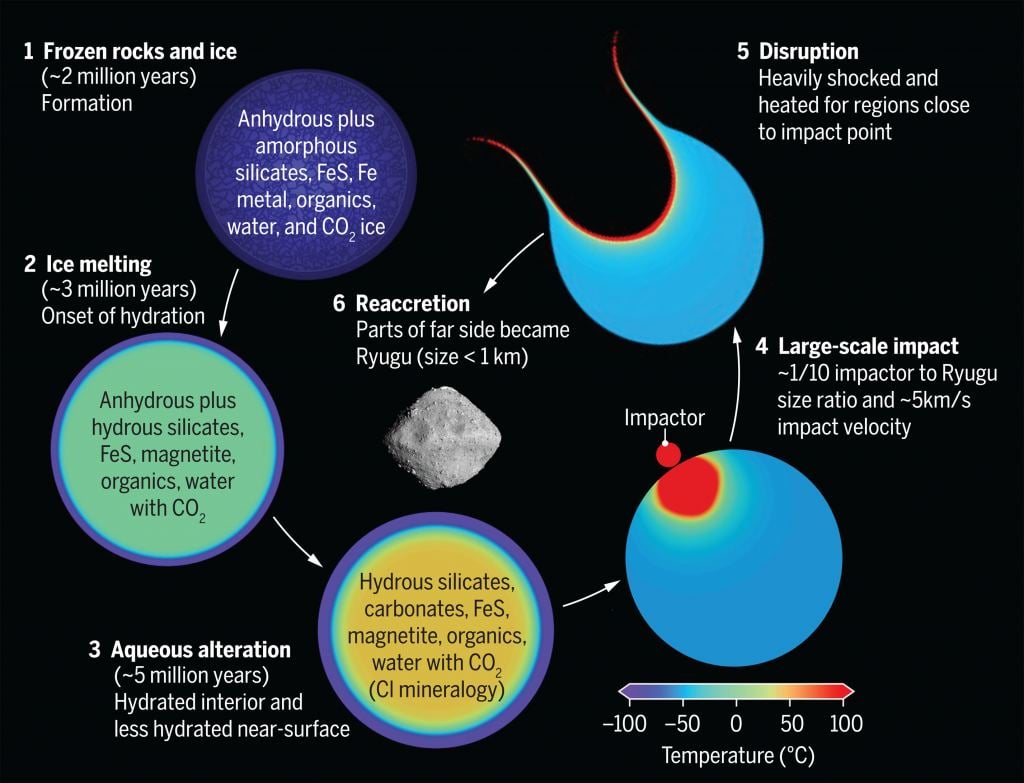In June 2018, Japan's Hayabusa 2 mission reached asteroid 162173 Ryugu. It studied the asteroid for about 15 months, deploying small rovers and a lander, before gathering a sample and returning it to Earth in December 2020.
The Ryugu sample contains some of the Solar System's most ancient, primitive, and unaltered material, opening a window into its earliest days about 4.6 billion years ago.
The Ryugu sample is small, only about 5.4 grams (0.19 oz). However, scientific instruments that examine the sample's chemical characteristics don't need a large sample.
In new research, scientists examined tiny fragments of Ryugu using the Argonne National Laboratory's Advanced Photon Source (APS). The APS is a particle accelerator that accelerates photons to nearly the speed of light. These photons release X-rays that are used in a wide variety of scientific endeavours. (The APS was even involved in developing COVID-19 vaccines.) In this research, the APS X-rays were used in a special technique called Mössbauer spectroscopy that can determine the oxidation rate of iron in the Ryugu sample.
The research is titled " Formation and evolution of carbonaceous asteroid Ryugu: Direct evidence from returned samples." It's published in the journal Science, and the lead author is Tetsuya Nakamura from Tohoku University in Sendai, Japan.
Ryugu is a rare type of asteroid. As a Cb spectral type, it has characteristics of both C-type carbonaceous asteroids, the most common type by far, and B-type asteroids, a more uncommon type of carbonaceous asteroid.
JAXA, the Japan Aerospace Exploration Agency, chose Ryugu for their sampling mission for several reasons. As a Near-Earth Asteroid (NEA), Ryugu was easier to reach. It's also classified as a primitive, carbon-rich asteroid, so they hoped it would contain organic chemicals that hold clues about the early Solar System. Ryugu is also relatively small (900 metres) and rotates slowly, making sampling easier. The asteroid's orbit also brings it close to Earth, making it easier to return the sample.
Ryugu could answer certain questions, all related to the history of the Solar System. Ryugu's structure and composition, including the presence of water and organic matter, can reveal details about how planets and asteroids formed and how these essential materials for life may have been delivered to Earth. Scientists also hoped to classify Ryugu in more detail and understand its internal structure and how it might have evolved. Researchers also wondered about the asteroid's resource potential.
Scientists working with the samples have already learned a lot. They've found that the asteroid is rich in organic matter, which supports the idea that asteroids could have delivered these materials to Earth. Ryugu contains water-bearing minerals, which is evidence that it held more water or water ice in the past. Scientists have also detected the effects of space weathering on the asteroid's surface and solar wind particles trapped within its grains.
This new research added to the bounty of knowledge provided by the tiny 5.4-gram sample. The researchers analyzed 17 Ryugu particles, ranging in size from 1 to ~8 mm. They were mostly interested in uncovering a more detailed understanding of the asteroid's history. They wanted to find answers to several specific questions:
- When and where did Ryugu's parent body form?
- What is the original mineralogy, elemental abundances as a whole, and chemical compositions of the accreted materials, including their ice content?
- How did these materials evolve through chemical reactions?
- How was Ryugu ejected from its parent?
The APS and its Mossbauer Spectroscopy revealed more detail about Ryugu, and the researchers used impact simulators and other tools to piece together the history of the asteroid and its parent.
The researchers found carbon dioxide-bearing water inclusions in a certain type of crystal. This is evidence that Ryugu's parent body formed in the outer Solar System, where cold temperatures allowed water ice to be incorporated. APS also identified a large concentration of pyrrhotite in the sample. Pyrrhotite is an iron sulphide found nowhere in meteorite fragments that resemble Ryugu. This helps limit the location and temperature of the parent body when it formed. The research team says that the parent body formed about 1.8 million to 2.9 million years after the beginning of Solar System formation.
In the outer Solar System, materials that form at low temperatures are dominant, and Ryugu's parent was largely made of ice. The parent body formed beyond the H2O and CO2snow lines and possibly beyond Jupiter.
The samples are porous and fine-grained, indicating that the parent contained ice that melted over a long period of time. The researchers say that radioactive heating in the parent body's interior melted the water ice about three million years ago. Over time, reactions between the water and rock slowly changed the asteroid's initial anhydrous mineralogy to a largely hydrous mineralogy.
The material was initially less altered at shallow depths and more hydrous at deeper depths. After about five million years, all of the material in the parent body reached its maximum temperature, and aqueous alteration continued.
The catastrophic head-on collision that blasted Ryugu's parent happened about one billion years ago. The parent was about 50km in diameter, and the impactor was about 6 km. Ryugu isn't a single chunk of its parent. Instead, it's a rubble pile asteroid, a collection of debris dislodged from its parent body by the impact. Ryugu's material originated at different depths on the opposite side of its parent from the impact and then coagulated into Ryugu.
This research helps paint a timeline of Ryugu's parent and Ryugu itself on its long journey through the Solar System.
Ryugu itself began its journey as part of a larger body only about two million years after the birth of the Solar System. After billions of years as part of its parent body, it was created in the aftermath of a collision. After a long time, it made its way into its near-Earth orbit, and in the last blink of an eye, humanity arose and built a technological civilization. We've reached out and sampled this messenger from the past, and it's taught us a lot about our Solar System's history.
Hayabusa 2 is now on an extended mission to visit two other asteroids. In 2026, it will perform a high-speed fly-by of the S-type asteroid 98943 Torifune. In 2031, it will rendezvous with 1998 KY26, a small 30m asteroid that is a fast rotator.
Hayabusa 2 won't sample either of these asteroids, but its observations will add to its already impressive contribution.
 Universe Today
Universe Today



